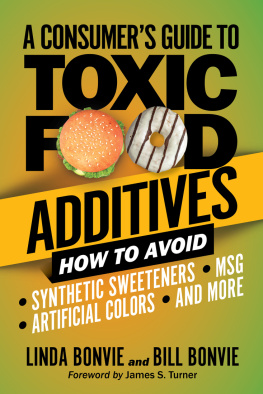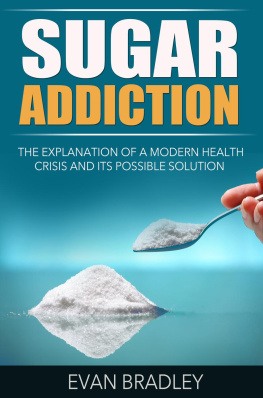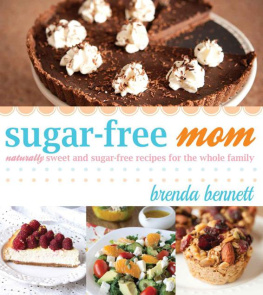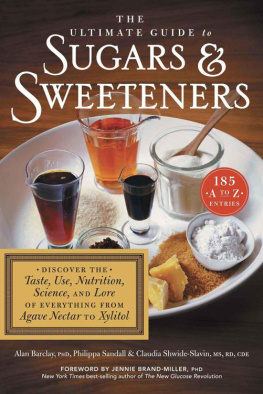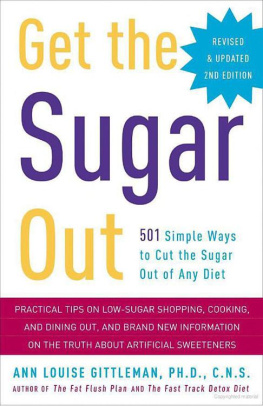ODonnell Kay - Sweeteners and Sugar Alternatives in Food Technology
Here you can read online ODonnell Kay - Sweeteners and Sugar Alternatives in Food Technology full text of the book (entire story) in english for free. Download pdf and epub, get meaning, cover and reviews about this ebook. City: Ames;Iowa;Chichester;West Sussex;UK, year: 2012, publisher: Wiley-Blackwell, genre: Romance novel. Description of the work, (preface) as well as reviews are available. Best literature library LitArk.com created for fans of good reading and offers a wide selection of genres:
Romance novel
Science fiction
Adventure
Detective
Science
History
Home and family
Prose
Art
Politics
Computer
Non-fiction
Religion
Business
Children
Humor
Choose a favorite category and find really read worthwhile books. Enjoy immersion in the world of imagination, feel the emotions of the characters or learn something new for yourself, make an fascinating discovery.

- Book:Sweeteners and Sugar Alternatives in Food Technology
- Author:
- Publisher:Wiley-Blackwell
- Genre:
- Year:2012
- City:Ames;Iowa;Chichester;West Sussex;UK
- Rating:4 / 5
- Favourites:Add to favourites
- Your mark:
- 80
- 1
- 2
- 3
- 4
- 5
Sweeteners and Sugar Alternatives in Food Technology: summary, description and annotation
We offer to read an annotation, description, summary or preface (depends on what the author of the book "Sweeteners and Sugar Alternatives in Food Technology" wrote himself). If you haven't found the necessary information about the book — write in the comments, we will try to find it.
Sweeteners and Sugar Alternatives in Food Technology — read online for free the complete book (whole text) full work
Below is the text of the book, divided by pages. System saving the place of the last page read, allows you to conveniently read the book "Sweeteners and Sugar Alternatives in Food Technology" online for free, without having to search again every time where you left off. Put a bookmark, and you can go to the page where you finished reading at any time.
Font size:
Interval:
Bookmark:
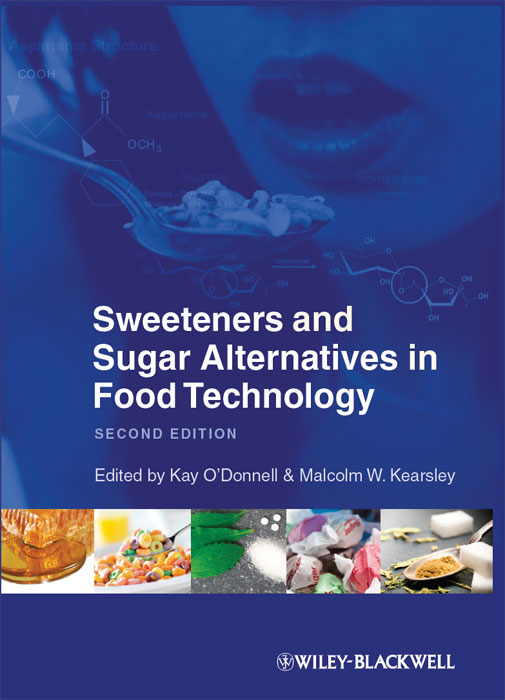
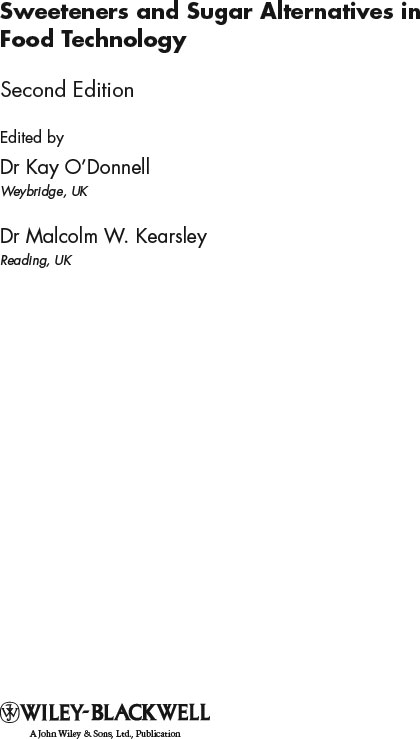
This edition first published 2012 2012 by John Wiley & Sons, Ltd.
First edition Blackwell Publishing Ltd.
Wiley-Blackwell is an imprint of John Wiley & Sons, formed by the merger of Wiley's global Scientific, Technical and Medical business with Blackwell Publishing.
Registered office:
John Wiley & Sons, Ltd, The Atrium, Southern Gate, Chichester, West Sussex, PO19 8SQ, UK
Editorial offices:
9600 Garsington Road, Oxford, OX4 2DQ, UK
The Atrium, Southern Gate, Chichester, West Sussex, PO19 8SQ, UK
2121 State Avenue, Ames, Iowa 50014-8300, USA
For details of our global editorial offices, for customer services and for information about how to apply for permission to reuse the copyright material in this book please see our website at www.wiley.com/wiley-blackwell .
The right of the authors to be identified as the authors of this work has been asserted in accordance with the UK Copyright, Designs and Patents Act 1988.
All rights reserved. No part of this publication may be reproduced, stored in a retrieval system, or transmitted, in any form or by any means, electronic, mechanical, photocopying, recording or otherwise, except as permitted by the UK Copyright, Designs and Patents Act 1988, without the prior permission of the publisher.
Designations used by companies to distinguish their products are often claimed as trademarks. All brand names and product names used in this book are trade names, service marks, trademarks or registered trademarks of their respective owners. The publisher is not associated with any product or vendor mentioned in this book. This publication is designed to provide accurate and authoritative information in regard to the subject matter covered. It is sold on the understanding that the publisher is not engaged in rendering professional services. If professional advice or other expert assistance is required, the services of a competent professional should be sought.
Library of Congress Cataloging-in-Publication Data
Sweeteners and sugar alternatives in food technology / edited by Kay O'Donnell, Malcolm Kearsley. 2nd ed.
p. cm.
Includes bibliographical references and index.
ISBN 978-0-470-65968-7 (hardcover : alk. paper) 1. Sweeteners. 2. Sugar substitutes.
3. Sugars in human nutrition. I. ODonnell, Kay. II. Kearsley, M. W.
TP421.S938 2012
664.5dc23
2012010720
A catalogue record for this book is available from the British Library.
Wiley also publishes its books in a variety of electronic formats. Some content that appears in print may not be available in electronic books.
Cover images: Background: Stockphoto.com/Lighthaunter ; Cereal: iStockphoto.com/LauriPatterson ;
Stevia leaf: iStockphoto.com/dirkr ; Sweets: iStockphoto.com/Juanmonino ;
Stevia Powder: iStockphoto.com/olm26250
Cover design by Steve Thompson
Preface
Indulgence in sweet foods and drinks is a human weakness and both are consumed far beyond their value in relieving hunger and thirst. Sweetness is most commonly associated with sucrose, and this is the most widely consumed sweetener in the world although it has been criticised for many years by some with regard to its contribution to obesity, dental caries and other diseases. While glucose (and fructose) syrups are widely used to replace sucrose in foods, this is largely a cost-saving exercise and does not address many of the problems associated with sugar consumption.
Over the last 30 years, a wide range of sugar replacers have been developed and marketed. These include the bulk sweeteners the polyols, which replace sucrose and glucose on a weight for weight basis, and the high-potency sweeteners where a kilogram of sugar in a food product might be replaced by a few grams of a very sweet material. In the case of high-potency sweeteners, this has led to the development of a parallel industry to provide ingredients, which can be used in conjunction with the sweetener to retain the bulk of the traditional product. More recently, sugars with many of the properties of bulk sweeteners and sweet taste enhancers that increase the potency of sweet compounds have been new additions to the market.
Replacement of sugars in foods has given us a new perspective on healthy foods where claims such as sugar-free, no-added-sugar and reduced calorie/sugar are being exploited by food manufacturers.
The use of ingredients to improve the nutritional status of a food product is one of the major driving forces for new product development, and sugar replacement is still seen as an area for development. This book provides a unique reference for food scientists and technologists with information on sugar replacement options to produce foods that not only taste and perform as well as sugar-based products but also offer consumer benefits including calorie reduction, dental health benefits, digestive health benefits and improvements in long-term disease risk through strategies such as dietary glycaemic control.
This second edition of Sweeteners and Sugar Alternatives follows the same basic layout as in the successful first edition with many of the same authors contributing to their relevant areas of expertise. New chapters on isomaltulose, trehalose and developments in sweeteners have been included to reflect changes in the use and understanding of sweeteners and sweet taste. For ease of reference, the book is set out as follows:
The summary tables at the end of each chapter and the extensive references are meant to inspire those who wish to learn more.
A sincere thanks to all the contributors to the book.
Kay ODonnell and Malcolm W. Kearsley
Contributors
Michael Auerbach
Regulatory Advisor
Active Nutrition, DuPont Nutrition & Health
NY, USA
Peter de Cock
Cargill
Vilvoorde, Belgium
Anne-Karine Dedman
Technical Manager
Active Nutrition, DuPont Nutrition & Health
Font size:
Interval:
Bookmark:
Similar books «Sweeteners and Sugar Alternatives in Food Technology»
Look at similar books to Sweeteners and Sugar Alternatives in Food Technology. We have selected literature similar in name and meaning in the hope of providing readers with more options to find new, interesting, not yet read works.
Discussion, reviews of the book Sweeteners and Sugar Alternatives in Food Technology and just readers' own opinions. Leave your comments, write what you think about the work, its meaning or the main characters. Specify what exactly you liked and what you didn't like, and why you think so.

